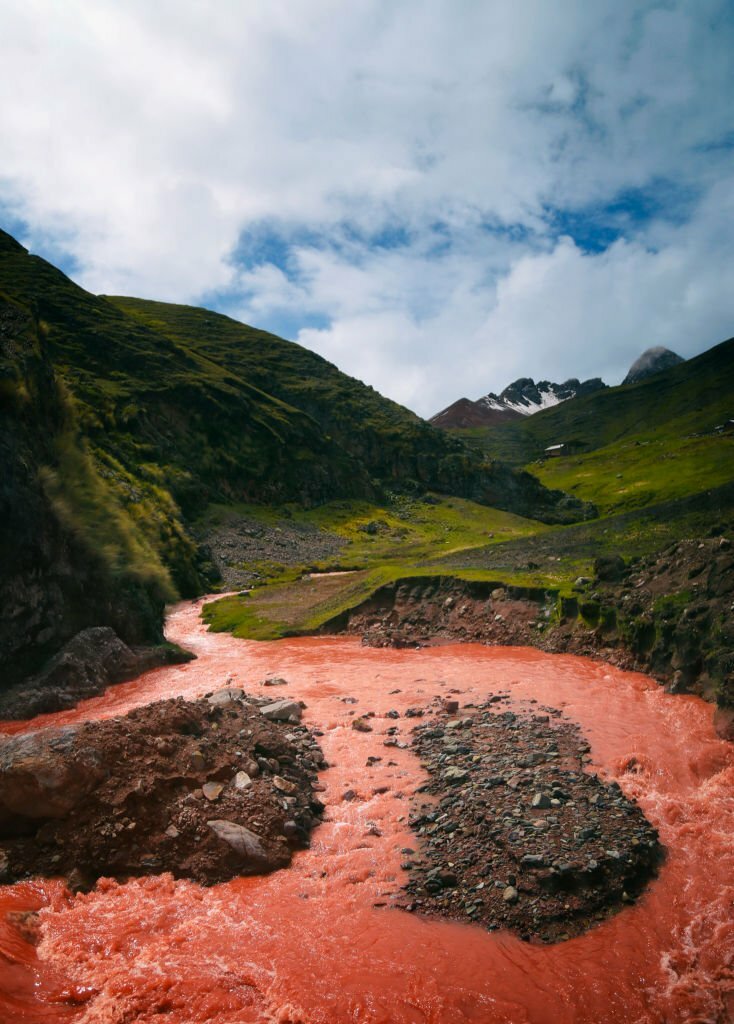Peru, a land blessed with diverse landscapes and natural wonders, is home to the captivating Rio Tinto, a red river that winds its way through the Andean highlands. This unique and enigmatic waterway, not to be confused with its more famous Spanish counterpart, offers a mesmerizing display of vibrant red hues, creating a striking contrast against the backdrop of the Andean scenery. As travelers venture into the realm of the Rio Tinto, they are greeted by a spectacle that weaves together geological intrigue, ecological resilience, and the rich tapestry of Peruvian landscapes.
1. Geological Marvel:
The Rio Tinto, which translates to “Red River” in Spanish, derives its distinctive color from the high concentration of iron and other minerals in its waters. The river’s red hue is a result of the oxidation of iron, a process that occurs when the iron in the rocks reacts with oxygen and water. The geological uniqueness of the Rio Tinto adds a surreal and otherworldly dimension to its already breathtaking surroundings.
2. Location and Watershed:
The Rio Tinto flows through the Andean region of Peru, primarily in the southern part of the country. Its watershed encompasses a diverse range of landscapes, from high-altitude mountainous terrain to valleys and agricultural areas. The river’s course takes it through regions with a rich history, including proximity to archaeological sites and ancient Inca trails.
3. Cultural Significance:
Beyond its geological marvels, the Rio Tinto holds cultural significance for the local communities that reside along its banks. In some areas, the river is integrated into agricultural practices, providing water for crops and livestock. Additionally, the surrounding landscapes are often dotted with traditional villages, offering travelers a glimpse into the daily life and customs of the Andean people.
4. Biodiversity Amidst Uniqueness:
While the Rio Tinto’s acidic and mineral-rich waters may seem inhospitable, the river supports a surprising array of microorganisms and extremophiles. These organisms have adapted to the challenging conditions of the river, showcasing the resilience of life in extreme environments. The biodiversity around the Rio Tinto adds ecological intrigue to its already captivating allure.
5. Tourism and Exploration:
As awareness of the Rio Tinto’s uniqueness has grown, the area has become an increasingly attractive destination for eco-tourism and geological exploration. Travelers can embark on guided tours to witness the striking red waters, explore the surrounding landscapes, and gain insights into the geological processes that have shaped this natural wonder over millennia.
6. Conservation Challenges:
Despite its natural beauty, the Rio Tinto faces environmental challenges, including concerns related to water quality and ecosystem health. Balancing the preservation of this unique natural wonder with sustainable tourism and responsible land management is an ongoing challenge, underscoring the importance of conservation efforts in the region.
7. The Rio Tinto in Mythology:
The Rio Tinto has been a source of inspiration and wonder for centuries, and it even finds mention in local myths and legends. The red coloration of the river has been associated with mythical narratives, adding a layer of cultural richness to the geological marvel. Exploring the Rio Tinto allows travelers to connect with both the tangible geological processes and the intangible cultural stories that surround this extraordinary waterway.
In conclusion, the Rio Tinto stands as a testament to the geological wonders that grace the landscapes of Peru. Its vibrant red waters, shaped by the alchemy of minerals and the forces of nature, create a visual symphony that captivates the imagination. As travelers journey along the Rio Tinto, they not only witness a geological marvel but also delve into the cultural and ecological complexities that define this enigmatic river in the heart of the Andes.
Book ticket here.










Comment (0)